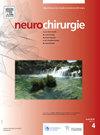Combined endoscopic endonasal transsphenoidal and microscopic transcranial approaches for the primary resection of giant pituitary adenomas
IF 1.4
4区 医学
Q4 CLINICAL NEUROLOGY
引用次数: 0
Abstract
Aim
Giant pituitary adenomas often present as dumbbell-shaped or multilobulated, presenting significant challenges for surgical treatment. Currently, there is no universally recognized optimal surgical strategy for choosing a dual-scope approach for primary or staged resection. This study aims to present surgical cases and clinical experience with endoscopic endonasal transsphenoidal combined with microscopic transcranial approaches for the primary resection of giant pituitary adenomas.
Material and methods
Ten patients with giant pituitary adenomas underwent one-stage surgical resection using endoscopic endonasal transsphenoidal combined with microscopic transcranial approaches. Imaging findings and treatment outcomes were subsequently reviewed.
Results
All patients underwent single-stage tumor resection using endoscopic endonasal transsphenoidal combined with microscopic transcranial approaches. Nine patients underwent total resection, while one patient underwent near-total resection. Postoperatively, visual acuity improved in six patients, while four patients experienced no significant change in visual acuity. One patient experienced cerebrospinal fluid leakage postoperatively and underwent a second repair. One patient developed a postoperative infection, and one developed hypopituitarism. No deaths or serious complications occurred.
Conclusion
Single-stage resection of giant pituitary adenomas using endoscopic endonasal transsphenoidal combined with microscopic transcranial approaches facilitates complete tumor resection, minimizes the need for residual tumor and staged surgeries, and reduces postoperative bleeding due to tumor remnants. This method improves the total resection rate and reduces postoperative complications and mortality, demonstrating significant effects and clinical application value, making it worthy of promotion.
经鼻内窥镜和经颅镜联合入路治疗垂体巨大腺瘤。
目的:巨大垂体腺瘤常表现为哑铃状或多分叶状,对手术治疗提出了重大挑战。目前,对于选择双镜入路进行原发性或分期切除,尚无普遍认可的最佳手术策略。本研究旨在报告经鼻内镜蝶窦联合经颅镜入路原发性切除垂体巨大腺瘤的手术病例及临床经验。材料与方法:对10例巨大垂体腺瘤采用经鼻内镜蝶窦联合经颅镜入路一期手术切除。随后回顾影像学表现和治疗结果。结果:所有患者均采用鼻内经蝶联合显微经颅入路行单期肿瘤切除术。9例患者行全切除,1例患者行近全切除。术后6例患者视力改善,4例患者视力无明显变化。1例患者术后出现脑脊液漏,并进行了第二次修复。1例患者发生术后感染,1例发生垂体功能减退。无死亡或严重并发症发生。结论:经鼻内窥镜经蝶窦联合经颅镜入路单期切除垂体巨大腺瘤,有利于肿瘤完全切除,减少残留肿瘤和分期手术,减少术后肿瘤残留出血。该方法提高了全切除率,降低了术后并发症和死亡率,效果显著,具有临床应用价值,值得推广。
本文章由计算机程序翻译,如有差异,请以英文原文为准。
求助全文
约1分钟内获得全文
求助全文
来源期刊

Neurochirurgie
医学-临床神经学
CiteScore
2.70
自引率
6.20%
发文量
100
审稿时长
29 days
期刊介绍:
Neurochirurgie publishes articles on treatment, teaching and research, neurosurgery training and the professional aspects of our discipline, and also the history and progress of neurosurgery. It focuses on pathologies of the head, spine and central and peripheral nervous systems and their vascularization. All aspects of the specialty are dealt with: trauma, tumor, degenerative disease, infection, vascular pathology, and radiosurgery, and pediatrics. Transversal studies are also welcome: neuroanatomy, neurophysiology, neurology, neuropediatrics, psychiatry, neuropsychology, physical medicine and neurologic rehabilitation, neuro-anesthesia, neurologic intensive care, neuroradiology, functional exploration, neuropathology, neuro-ophthalmology, otoneurology, maxillofacial surgery, neuro-endocrinology and spine surgery. Technical and methodological aspects are also taken onboard: diagnostic and therapeutic techniques, methods for assessing results, epidemiology, surgical, interventional and radiological techniques, simulations and pathophysiological hypotheses, and educational tools. The editorial board may refuse submissions that fail to meet the journal''s aims and scope; such studies will not be peer-reviewed, and the editor in chief will promptly inform the corresponding author, so as not to delay submission to a more suitable journal.
With a view to attracting an international audience of both readers and writers, Neurochirurgie especially welcomes articles in English, and gives priority to original studies. Other kinds of article - reviews, case reports, technical notes and meta-analyses - are equally published.
Every year, a special edition is dedicated to the topic selected by the French Society of Neurosurgery for its annual report.
 求助内容:
求助内容: 应助结果提醒方式:
应助结果提醒方式:


